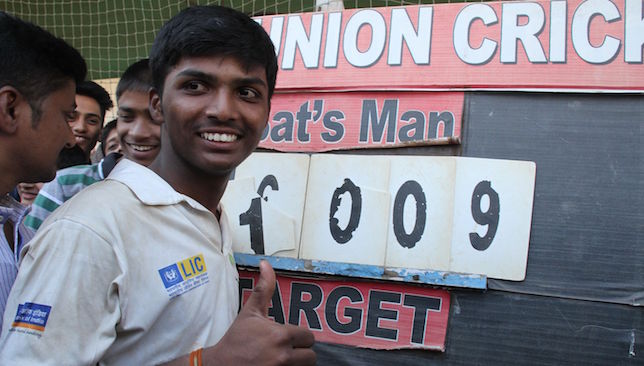
Context is very important when it comes to analysing performances. In cricket as well, simple statistics can often lead to some conclusions that aren’t always correct. The latest incident to spark debate on the value of performance came at the U-16 level in India.
Controversy erupted after local hero Pranav Dhanawade didn’t make the cut for the U16 West Zone squad while Arjun Tendulkar found a place in the team. Dhanawade is the same lad who scored a world record 1009 not out off just 323 deliveries against Arya Gurukul school in January this year – the highest score ever recorded in any form of the game.
And Arjun is the son of Sachin Tendulkar. As expected, accusations of influence overpowering merit flooded social media.
For a moment, let’s forget the fact that Dhanawade was actually ineligible for selection because he had never been picked for his domestic side Mumbai; his mega knock came after the Mumbai team had been selected and that meant he couldn’t have been named in the West Zone side.
The issue here is perception. Dhanawade’s one innings was perceived as decidedly better than Arjun’s all-round effort last year where he scored a century and picked up four wickets in a match that was actually a part of the selection process.
What cricket fans overlook is that Dhanawade’s knock came while facing 10-year-old kids who were not even in the same age league and were bowling with a full size ball for the first time on a field where boundary ropes were at 30 yards. And even then, Dhanawade gave an astonishing 25 chances. It was not a contest in any sense.
Child prodigees | School cricket 1007 run world record holder Pranav Dhanawade met Sachin Tendulkar pic.twitter.com/p66EuUtLMX
— MUMBAI NEWS (@Mumbaikhabar9) February 14, 2016
What amazes me is how statistics can paint a picture that is far removed from reality.
If one takes a look at Test bowlers, India off-spinner Harbhajan Singh is above Pakistan’s swing king Wasim Akram in wicket’s tally. Harbhajan has 417 from 103 matches while Akram has 414 from 104. If one considers matches where their teams have won, Bhajji comes out on top once again with his tally of 221 wickets against Akram’s 211.
Looking at numbers, Harbhajan looks to have made a greater impact but I have yet to come across a person who rates the off-spinner higher than the left-arm quick. Akram is arguably the finest left-arm bowler in history while there are many off-spinners, let alone spinners, who are considered better than Harbhajan.
It all comes down to context. For most of his career, Akram played alongside Waqar Younis, a pacer equally adept at wreaking havoc with his pace and swing.
Then there were masterful slow bowlers like Mushtaq Ahmed and Saqlain Mushtaq who were seldom unsuccessful.
Tearway quicks like Shoaib Akhtar and all-rounders like Azhar Mahmood and Abdul Razzaq also battled for wickets while Akram was playing. So it was with such healthy competition in his team that Akram carved a niche for himself in the game.
Harbhajan, on the other hand, played a big chunk of his career as the main wicket taker for his side. Out of his 103 Tests, 54 were played alongside leg-spinning legend Anil Kumble. In the rest, there was only left-arm pacer Zaheer Khan who could match Harbhajan for stature and impact. With such low competition within the side, Bhajji had more chances to take wickets, which he did.
So the next time you come across a singular statistic, don’t let it shape your judgment. There are many stories behind such numbers.
There was a time when foreign coaches were all the rage in Indian cricket. It started with John Wright at the start of the century and was followed by appointments of Greg Chappell, Gary Kirsten and Duncan Fletcher at the helm.
While the tenures of Wright and Kirsten were fruitful, Chappell and Fletcher’s were failures of varying degrees.
Following the epic capitulation endured by the team during Fletcher’s reign, India decided to look within their system. Former batsman Ravi Shastri was given the task of managing the team while Sanjay Bangar and Bharat Arun were made the batting and bowling coaches.
It was a system that worked very well as familiarity with the Indian system and players helped these individuals support a young team that was in a transition phase.
And now that the Indians are looking for a new head coach, many ex-India players have thrown their hat in the ring.
Former international batsmen like Sandeep Patil, Lalchand Rajput and Vikram Rathour have expressed their desire to help manage the national side and it marks a shift in the thinking of the board.
Communication with the national players is being given a priority and it is perfectly logical to have people who can speak the same language as the cricketers. And anyhow, at the top level it is all about man management.
On those parameters, having a ‘local’ support staff makes great sense.